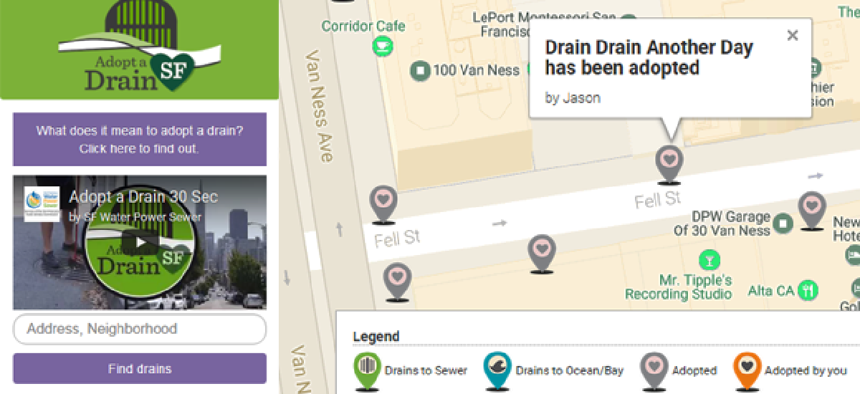San Francisco takes on local flooding with Adopt a Drain

The city modified the open source code from Boston’s Adopt a Hydrant program, which lets residents volunteer to shovel out fire hydrants buried by snowstorms.
San Francisco has teamed with civic tech volunteers to encourage residents to adopt, monitor and care for city drains.
The city’s Adopt a Drain program features a website showing about 25,000 storm drains and catch basins that the city maintains. Residents can choose a drain to maintain, which means clearing debris when drains gets clogged to improve rainwater flow and limit local flooding.
The project is a collaboration between volunteers at Code for San Francisco and the San Francisco Public Utilities Commission, Public Works and DataSF. The agencies worked together to produce a drain dataset that Code for San Francisco used to load drain locations into the application, according to a blog post by the city’s Open Data Program Manager Jason Lally. All the project coding, managing and tracking is done on GitHub.
San Francisco got the open source code for its Adopt a Drain program by modifying code from the Code for America project in Boston, Adopt a Hydrant, which lets residents volunteer to shovel out fire hydrants buried by snowstorms.
Like Adopt a Hydrant, San Francisco’s app shows a map of drains and gives users the option to search for drains by neighborhood or address. It displays drains already adopted by others and the names the drains have been given.
Other cities have also leveraged Code for America’s open source code for similar applications. Adopt a Drain is also being used in Oakland, Calif., and Honolulu created an Adopt a Siren program that encourages maintenance of tsunami sirens.
So far in San Francisco, more than 1,000 drains have been adopted by hundreds of volunteers, and part of the draw was the ability to name the drains, according to a report in the San Francisco Chronicle. Puuurple Drainnnn, The Great Leaf Catcher, No Drain No Gain and Denny the Drain are among then nearly 600 named drains.
The project has also encouraged the city to engage with more data. The Public Utilities Commission’s communications staff has started using additional data to target outreach and track campaigns and media coverage through web analytics to measure the program’s impact.
NEXT STORY: What's Causing Chicago’s Homicide Spike?





